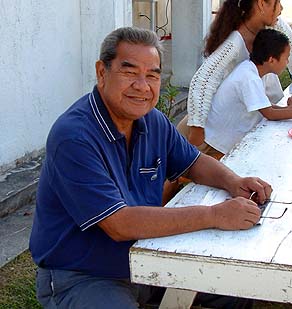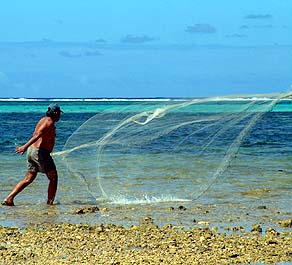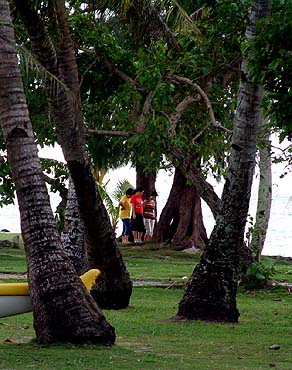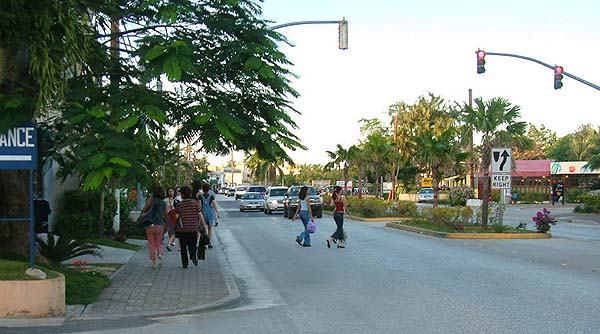 |
 |
 |
|||||
|
|
|
|
|
|
|
|
|
|
|
|||||||
|
|
|
|
Street scene in Tanapag.
|
|
“It is very interesting, the assimilation of populations in this village," Ben remarks. "In the olden days, when I was growing up, maybe five, six, seven years old, it was all Carolinian that I heard spoken, but at home we spoke Chamorro. And I don’t remember seeing people from Chuuk or people from Palau. It was a very tight-knit organization, and anybody who came in here got in trouble with us. "We in this village are known to be troublemakers, but of course, the whole idea is just protecting the community. So whenever somebody came in here, and we didn’t feel good about it, and they didn’t act properly themselves, we would stand up and fight for our rights. Whatever that right might be."
|
||
|
|
||
“This village has five clans, though there are only three that I know of here today. The most populous clan is the Remar clan. There’s also a Rewiite clan and there’s a Refalamei clan. The majority of the village is the Remar clan, and it seems like only the Remar and the Rewiite are still in existence here in the village today. I don’t know of any Refalamei here now, but they were here before. “We know we have an actual connection to the Remar people back in the Caroline Islands. If we were to go right now to the atoll of Namon Weite, on the island of Makur, that’s where the Remar Clan is very strong. They’re the chiefs of that island. Now if we go to Unoun, it could be Rewiite."
|
|
|
“The living Paramount Chief here in the village is Victorino Nekai Igitol. It’s the Nekai, the mother’s side, that brought him forth to his being a Paramount Chief. He would call meetings. He would direct the fiestas for our church. He would welcome voyagers from the central Carolines, and be very active during their stay. Whatever we need; we usually look upon the chief to make those decisions. “We continue to maintain the traditions under the clanship. I know politics have tremendously changed our thinking and behavior, but we still go back to our chief and ask for advice, ask for his wisdom, and of course he tries to make plans for the community to actively involve in social functions."
|
“The Chief today, if he says, ‘Pete, you don’t fish here anymore,’ I don’t know if Pete’s going to submit to that or not, because of the changing times and the assimilation of populations. The Chief could tell him not to fish, but the Chief cannot tell the Chamorro not to fish. If a Chamorro goes out and fishes, Pete ends up with the short end of the stick. Now the big question is, are you going to listen to your Chief?” “Traditionally,” Pete responds, “yes.” “We still have a chief,” Juan agrees, “but his position is not as recognized as it was before, and this is part of the Democratic system coming into this place. People started speeding up, and then we started losing this closely knit community, and so things started changing. But in our Carolinian society in the village, we still understand and know our clan."
|
|
|
|
|
“There is a large influx of people coming in and out of here,” comments Rosa Tenorio. “Tanapag is still not quite as open as San Roque, where there are all these hotels up and stuff like that. We still very much keep to ourselves. Now there are a couple of people that have come in here from elsewhere. We have a few Japanese and Korean business people." “And people from outside of CNMI come in as workers but they don’t own land here,“ Estella adds. “They just lease it. That one’s Chinese business there and these two are Korean. But this has not had an impact on the community.”
|
||
|
|
||
“There are people from other countries, like the Philippines, coming into our areas for working purposes,” Dave says, “they are sharing their culture with our cultures, so it’s some sort of an adoption into our culture as well. But the resources that we have on the island will also be consumed by the other people. So for instance, the fish that we have abundantly in the water, will also be shared with the other group of people who are not registered for our areas." “We do have a lot of problems with the factory workers,” Rosa Tenorio remarks. “Apparently there are a lot of these workers here. Somewhere in the neighborhood of ten thousand of them. That’s a lot of outsiders on this island. But I’ve seen very few, who have come out on weekends and such. "I don’t really have a problem with them coming out here to Tanapag and relaxing. They do come over to this beach here, because I provide a table there. When they sit, I tell them, ‘Okay enjoy it, but when you leave take your trash with you,’ because I am for a clean environment."
|
|
|
“The factory workers, I understand they have to go out sight-seeing and things like that, which is fine with me. But there are a lot of sand crabs around this village, and when the crabs come out, they harvest them. It’s okay to harvest something when you have a lot of it, but only in moderation. But these people don’t seem to know moderation. "That specific species is disappearing. Years and years ago, you could stand on one end of this beach, put a flashlight on the sand, and you’d see millions of them running. But ever since Saipan has opened up to these garment factories, with all these workers that have come in, the crabs have disappeared almost to extinction. Otherwise, we really don’t have much problem about people coming into the village and visiting.”
|
“I’ve seen the factory workers walking all over,” Ben says. “They’re picking coconuts, flowers, bananas here in the village. Well, maybe they do that wherever these people come from, but we frown on that. We say, ‘Hey, when did your father or mother plant those coconuts?’ You know, they go there and are just taking it down. “Otherwise they have had very little impact on the village. There was one major disaster, I should say. A Japanese guy got drunk, came out and mingled with the boys, and they killed him. And, up until today, we never know who killed him. "That kind of devastated us. It’s probably the first murder in our village. This assimilation of populations from different cultures kind of clashed, I guess. So that’s what happened. Unfortunately we were tagged as being a rough village."
|
|
|
|
|
|
| “We are a one-hearted people," Ben says.“In yesteryears, we guarded our village religiously because we carried on our culture, the Carolinian culture, where you protect and respect your elders. So people in other villages realized that you don’t fool around with the Carolinians or Chamorros in this village, because they will come back and hurt you.” "If someone from another village hurts one of our kids, almost everybody in this village will go and fight that other village to tell them that they shouldn't bother our children. And so other villagers are scared to come into our village. “Very few crimes are committed here; very few burglaries are committed here. I have not locked my truck or my house. It’s wide open, and that’s because of that guardianship that we instilled into the minds of other people, that you don’t come and fool around in the village because you’re going to get attacked. That’s where it becomes rough."
|
||
|
|
||
This strong sense of cohesion among Tanapag residents is reflected in the character of the village today.
|
||
|
|
||
|
|
|
|
|
|

|
| Tanapag Home | Map Library | Site Map | Pacific Worlds Home |
|
|
|
|

|
|
|
|||
| Copyright 2003 Pacific Worlds & Associates • Usage Policy • Webmaster |
|||









